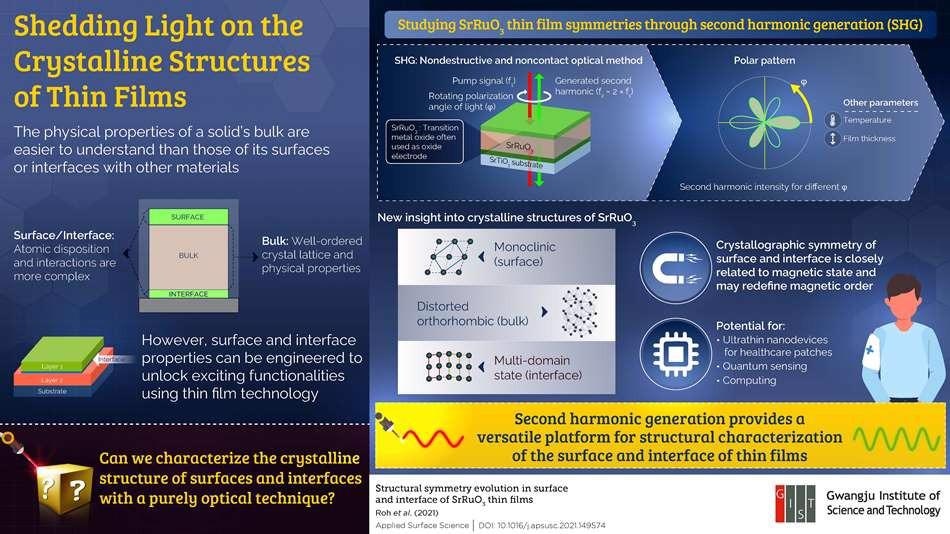In a new study, scientists develop a strategy to tackle the challenging task of analyzing material surfaces and interfaces.

Image Credit: Gwangju Institute of Science and Technology (GIST)
Understanding the physical properties of a material’s surface and interface is more challenging than understanding those of its inner bulk. In a recent study, scientists at GIST in Korea report an all-optical approach to analyze the crystallographic structure at the surface and interface of SrRuO3 thin films, an important metal oxide. Their strategy provides a platform for investigating the properties of thin films to unlock a variety of nanotechnological applications.
The renowned theoretical physicist Wolfgang Pauli once said: “God made the bulk; the surface was invented by the devil.” What he probably meant by this statement is that the properties of materials at their surface or interface with other materials are challenging to understand and manipulate, especially in comparison with the properties of the bulk.
Now, with the advent of nanotechnology and recent progress in thin film manufacturing, surface and interface properties offer a vast playground to engineer unprecedented functionalities and conduct physics research. Therefore, to take full advantage of thin film, it’s important that we find innovative ways to characterize the crystallographic structures at the surface and interface of relevant materials.
In a recent study published in Applied Surface Science, a team of scientists led by Associate Professor Jong Seok Lee from the Gwangju Institute of Science and Technology (GIST) in Korea reported a promising all-optical approach to analyze crystal structures in the bulk, interface, and surface of materials. The researchers employed their strategy to investigate thin films of SrRuO3, an interesting metal oxide widely used as an electrode and in oxide engineering. This study was carried out in collaboration with Seoul National University and the Institute for Basic Science, which are both in Korea. The study was made available online on March 19, 2021, and was published in Volume 553 of the journal on July 1, 2021.
The technique employed is called optical second-harmonic generation (SHG). It is a non-contact and nondestructive optical method that involves shining a pulsed laser onto a material and measuring the generated second harmonic light, which have twice the frequency. The trick is that by carefully aligning the incident laser beam perpendicular to the material plane on a rotating platform, the generated second harmonic light will reveal information about the crystalline symmetries. By changing the thickness of the SrRuO3 samples and their temperature, the scientists could suggest the structural phase diagram of the bulk, surface, and interface of the films. “Our findings may attract much attention in the condensed matter physics community not only for fully unveiling the structural symmetries of one of the most important transition metal oxides but also for providing a useful platform for the structural characterization of the surface and interface of thin films using purely optical techniques,” remarks Prof. Lee.
An important result is that it appears the crystallographic symmetries of the surface and interface, at least in SrRuO3, are closely related to the magnetic state and may even reorient the material’s magnetic ordering. This opens up a possible avenue for realizing multifunctional devices. As Prof. Lee explains, “It may be possible to leverage the magnetic properties and symmetries at the interface and surface to design ultrathin nanodevices with many degrees of freedom or control parameters, which will be useful for applications such as healthcare patches, ultrathin quantum devices, sensors, and more.”
Let us hope this work makes the surface of materials less difficult to investigate and easier to exploit!